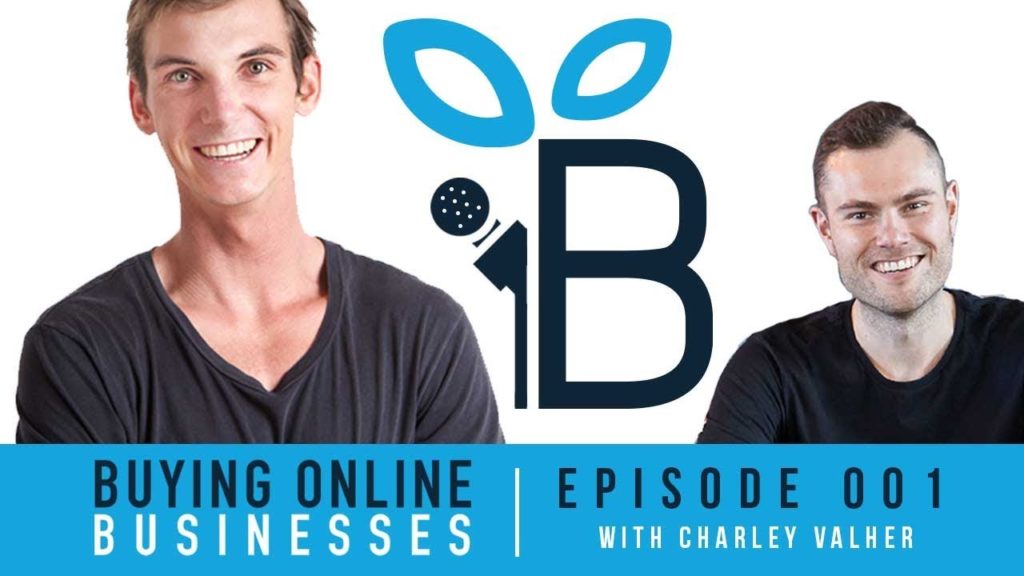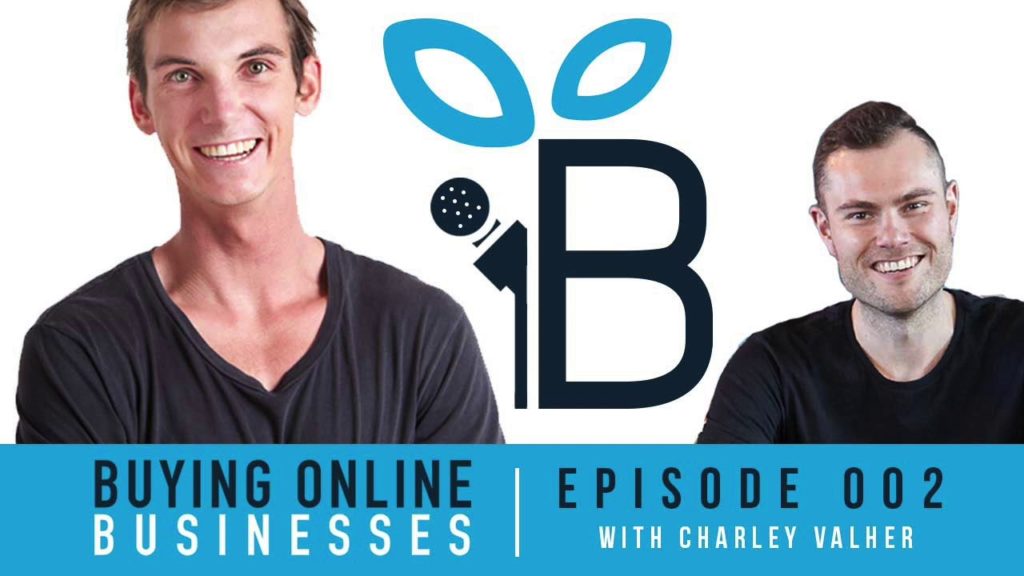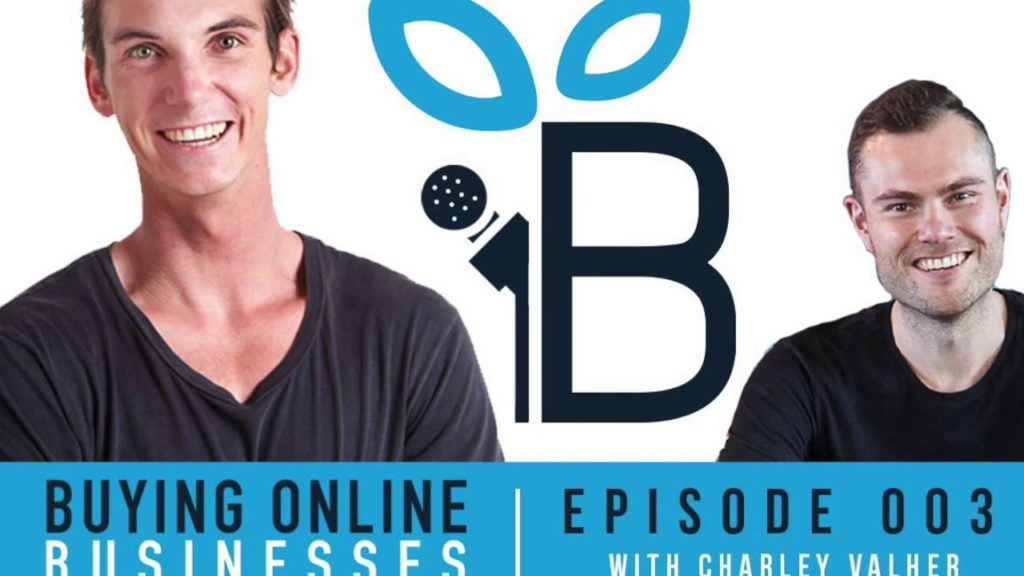I know it’s very tempting to include so much content on your website to convince your visitors to take action. But the more you add content and information, the harder it gets to navigate the site and overwhelms the users.
So how can you win both on User Experience and Conversions? That’s what we’re going to tackle today with AJ Davis.
AJ is a conversion rate optimization (CRO) specialist. She’s the founder of Experiment Zone, which helps online businesses grow their revenue by improving the user experience of their website using scientific methods.
Prior to starting Experiment Zone in 2017, AJ led optimization strategy for Fortune 500 companies during her tenure at Clearhead. She was also the lead UX researcher on the Google Optimize product.
I have invited AJ to share her thoughts on several issues regarding improving User Experience and CRO.
We have discussed why user experience is underrated and how important it really is? How to recreate the experience of buying something in-store or in-person and transform that online? What type of research and development can you do to get accurate data on how users like to go through their buying journey?
We also talked about how to do A/B test pages? What eCommerce product pages should be prioritized?
Ultimately, AJ shared the essential elements that go into a site experience audit.
If you are looking for ways to accelerate your online business, listen to this incredible episode and find out how to double your earnings.
Don’t miss out. Tune in now!
Get this podcast on your preferred platform:
RSS | Omny | iTunes | Youtube | Spotify | Overcast | Stitcher
Episode Highlights
02:06 Why you shouldn’t turn a blind eye on User Experience
04:07 How does A/B Testing fill the gap in User Experience
08:01 How can you help your customers pick the right product/service for them?
11:03 Information is the key to success
15:03 AJ’s key takeaway on creating a website
17:35 Building trust means increasing the Lifetime Value
19:25 Giving the right content at the right moment
22:52 What are the elements that a winning page has?
27:15 Is having reviews still important?
Courses & Training
Courses & Training
Key Takeaways
➥ The user experience brings the human element to the forefront. In the real world, user experience plays the role of figuring out and translating what people really do. How do they behave? And designing what will work.
➥ Some important factors for better user experience are having the right message, showing enough social proof, and having the right CTAs in the right places.
➥ When an A/B test doesn’t go the way as expected, it’s good to do qualitative research like an intercept survey on that page and ask people why they’re leaving or to understand if they have the information they need.
➥ One methodology that AJ’s team uses to create better user experience is called a usability study, where they observe people going through the site experience with specific goals in mind and just articulating out loud what they’re expecting to happen.
About The Guest
AJ Davis is a conversion rate optimization (CRO) specialist. She’s the founder of Experiment Zone, which helps online businesses grow their revenue by improving the user experience of their website using scientific methods.
Prior to starting Experiment Zone in 2017, AJ led optimization strategy for Fortune 500 companies during her tenure at Clearhead. She was also the lead UX researcher on the Google Optimize product.
Connect with AJ Davis
Transcription:
How would you like to double your conversions and double your income? Hi, I'm Jaryd Krause host of the buying online businesses podcast and today I'm speaking with AJ Davis who is a conversion rate optimization specialist. She is the founder of our experiment zone, which has helped online businesses grow their revenue by improving the user experience of the website using scientific methods. Now prior to starting experiment zone in 2017, AJ led optimization strategy for Fortune 500 companies.
During her tenure at Clearhead, she was also the lead UX researcher, user experience researcher on the Google Optimize product. Now in this podcast episode, AJ and I specifically talk about why user experience is underrated, and how important it really is for buyers and how it can increase conversions. We also talked about how to recreate the experience of buying something in store or in person and transforming that to the online space, transforming it but to your site and how people buy online. Through your business. We also talk about what type of research and development you can do to get accurate data using science of how users like to go through their buying journey, using accurate data and then transforming that into A/B tests in pages.
And using the scientific or data to make sure that the user experience is improved. And again, again, with using A/B testing pages, we talk about what they are we also talk about what most ecommerce product pages should prioritize in terms of what should be at the top of the page, what should be, you know, below the fold? And what are the key things that buyers love to have? Is it images? Is it free shipping?
Is it social proof and in what order are and what else should be on the page to make sure that buyers have a great user experience and they are in the position to be able to go away and make that purchase. Now, this is such a juicy podcast episode, you guys are absolutely going to love it. Let's dive in. Hello, AJ, welcome to the buying online businesses podcast.
AJ Davis (2:03)
Hey, nice to be here.
Jaryd Krause (2:05)
I'm looking forward to this chat, because I am super into buyer’s experience and going through a buyer’s journey and what's hugely incorporated that is in the user experience of a website. And when particularly I guess you're normally working with E commerce businesses. But I want to ask you why is user experience so important? What are the some of the main things that we should be thinking about with user experience?
AJ Davis (2:35)
I mean, there's two parts of every piece of technology, right? There's what we've built. And then it's what people see. And so often we forget the human element. And user experiences bring that to the forefront. I came into this world because I was an economics student. And we were taught people behave certain ways. And all our models break down because people don't behave that way. And in the real world user experience plays the role of figuring out and translating. What do people really do? And how does that intersect with the technology we're building.
So what it means is that we're really taking into account how people act, how they behave in the real world, so that we're not just designing what we think will work. But what we know will work.
Jaryd Krause (3:15)
This is a huge conundrum for most businesses, because normally they start out with the goal in mind of making money, and forget that we're actually selling products and services to human beings here. And we I feel like as entrepreneurs, especially online entrepreneurs, and I can put my hand up I've been there is I've mostly optimize for money, user experience, actually is a part of that optimizing for money, but at the same time, you're making the experience better.
And this I guess, there's so many psychological things that come into it on how people feel when they purchase the product, and how they feel when they own the product and for how long they own that product. And the energy and excitement they have around a brand that they want to share with people because of the experience they had purchasing it. And I'd love to dive into some cool things that you have tweaked and stuff like that.
But first, we'll talk about that shortly. But where do people mostly go wrong with their user experience? Is it just that they just don't know? It is a thing. And people that try were to you know, what do they think they need to do versus what they actually should be doing for humans?
AJ Davis (4:21)
I think we've come a long way. So the beginning we would just design the thing and we'd say here's what I'm selling, here's what it costs and click Yes to buy. And I think we've matured beyond that to including, you know, things that make you feel a certain way or understanding you know, the context of the person, but there's still a big gap between the ideal persona and how we think they'll behave, and then how they actually act in the real world.
And that's where the power of an AV test comes into play where we can actually put two different experiences out in the world and really measure how people are responding to it. So I think that's the gap that's like the magic black box that a lot of companies have a handle on but most companies are missing out on is how do we use something like A/B testing to really learn what people really do, as opposed to like what we model that we think they should do, I'd say over the last 10 to 15 years we've been we've done a much better job of asking people questions, figuring out their pain points.
But we aren't doing a great job of translating that into designs that help them feel comfortable, have clear expectations on what's going to happen, get excited, feel like it's something they want to share something they're enthusiastic about. So I think there's still a long way to go. But at least we're starting to talk about it.
Jaryd Krause (5:33)
So those questions are, I guess, when it comes into sales and marketing, a lot of them would be helping people remove objections, I guess. And this is an assumption, would it be helping people remove, or at least understand their objections, so they don't have any fear in going through and purchasing the product? And the opposite? They like, oh, cool, I understand the shipping process, understand how long it's going to take? I understand like, it's going to take maybe a little bit longer to manufacture because we put a lot of love into what we do. Like, is that a big component of it?
AJ Davis (6:09)
Yeah, it's this balancing act about information, right? So I think of i Whenever I'm thinking about optimization on the web, I want to think about a physical store. And so you have to think of like the storefront, that first impression, like, what are people feeling when they see and driving by your store stopping in for the first time. But then you also have to think about the experience of comparing the products like having two things physically in front of you.
What are the what's the information you need to compare? Which one is better? Do you have too many choices? Do you have 100 Different shampoo bottles to choose from? How will you focus in? How can I help direct your attention to the one that's going to fit you best rather than having you read every label? So there's a lot of analogies around, you know, giving that overall feel, as well as being able to really focus in on browsing behaviors, or things that are going to help really seal that decision point. And for things like things like free shipping, or how long is it going to take to get there, that's where that analogy starts fall apart. Because those are things that are so obvious in the real world.
And so many stores are not making it obvious in a digital context, they make you work for it. So if you don't know how long it's going to take, or how much it's going to cost you to get it, you're going to really get lost along the path versus just like always having it be obvious that you're physically in a store. And you can just grab the item and take it home right now. So those are often like the lowest hanging fruit. So the things that just set really clear expectations about what's about to happen. And then the more nuanced things are how do I compare products? How do I move about the store? What's the checkout experience, like I really.
Jaryd Krause (7:37)
i really like that when people go to our site buying online businesses.com, we have a selector of three buckets of people that you know where they're at, on their journey, and what they need, what they want, and what they need help with, or what they think they want, and need help with. And then they can select and go through their own sort of journey and ends up to a point where like, alright, you can get this free tool, alright, we have this course or we can help you in this sort of way.
I guess that's one way that you can help people come to your site with very broad different positions that are in in their journey in their buying experience, if they're even buying or just checking you out. What are some other ways that you can help people select what direction they should take to get them the best product or service for them? That's like, actually, for them, not just, Hey, I'm a business owner, I want to make sure I can sell as many of these products for the right to the right people. But like, no, like the service, how do we have other ways that that's done?
AJ Davis (8:31)
I think the most, the most commonly done way is to have different like landing page experiences. So if we already know something's different about you, because of what you did, before you get to this website, we should absolutely create, I call it a curated experience, people sometimes call it personalized, it usually doesn't go as far as being about me, but more about me as a category, or the category. And then fortunately, things that already know what yeah, what's going on with me and what I already know, are down.
So that's the basics, just like getting them to the right place and then guiding them to a specific path. But in that you do kind of get them the right exits, because if they ended up in the wrong spot, you don't want to hide, you know, here's the emergency exit, or here's the, you know, take a left over here, if you're looking for a t-shirt, and I think you're looking for shoes, but then just like more generally, how do we guide people have different purposes or ways they like to move about information. So I like to think about think people who want to be searchers, they want to like type in the word, they want to look for something really specific. How can we help that person? I think about people who want to just browse and kind of naturally come across things.
They're the ones that like think about the physical store and what's on the endcaps what's going to capture their attention. We have to do the same thing digitally. And then you know, there are people who are just looking for someone who's going to be that you know, personal shopping assistant, and that can show up in a lot of different ways. Some stores are doing things like having a chat bot that's going to help be able to answer questions or point them a certain direction. I think more effective than that are Things like quizzes where it's like, here are the three or five guiding questions about who you are as a consumer and what you're looking for, what the occasion is.
And then we're going to point you to a subset of products. And then there's just a bunch of other ways using navigation and other design elements to really just help people feel secure, guide them to the bestselling products, instead of the old products list, put the new products first or put something that looks recommended for them based on what else they browse for. So there's a lot of smart ways to do it. But a lot of potential complexity can come from trying to explore all the options that wants to.
Jaryd Krause (10:33)
Yeah, definitely, I could imagine it would be a lot of data, a lot of testing, and a lot of resources. So I guess that's the approach when you when people come to the come to the site or the store? And then you also would have A/B testing on I guess from product page to product page? I don't know.
AJ Davis (10:52)
So I'm sorry. Go ahead. Finish that question.
Jaryd Krause (10:54)
I don't know where to go with this. I want to talk about one of the case studies that you've had. But I don't know whether you want to when do you want to talk about A/B testing between product pages first?
AJ Davis (11:03)
Let me tell you about, I'm going to actually take it a little different direction than ecommerce because we had a SaaS company that we worked with love it. And one of the key takeaways any listener could take for their own website, no matter what kind of website they do, if they're selling something or not, is complexity makes it harder for people to make decisions. So what we saw was, simplicity is good, but you have to get to the right kind of things that are simple.
So putting the wrong simple things on isn't any better than having it be buried the right information buried. So we worked with a client, where they had a landing page that was really curated for the moment, that audience was in their buyer’s journey. So they had some context, they were looking at some competitor information. And they just kept adding more information to it. They had product features, they had differentiators they had what to expect in the demo meeting.
They had testimonials they just had they had it all, they had a page that looked like one of those templates you find for what an ideal landing page should look like. And we kept exploring, how do we simplify some parts of this page? Or how do we make sure the value propositions are just right. And so it was a lot of things we were adding to the page or modifying on the page, but not reducing on a page. And we thought, you know, we were expecting a lot of that to really make some difference, because we often see if there's something missing that we get some added benefit when we add it back. But what we found is that over and over again, adding things to the page was adding either negative impact to conversion, or just wasn't really changing things at all, like people just weren't reacting to it.
So we decided to do some qualitative research, because sometimes you don't know why people do what they do. And so you've got to ask, and we studied their sales team. And we said, how do you guys close the deal for this point? Like, if you were talking to this person in real life? What is the conversation like? Where do you start the conversation? What kind of questions come up? Where do you end the conversation? Awesome.
And as simple as it sounds? Now, we just took the answers that they gave us, we took the here the three things that we say in the last conversation, we build a page that highlighted those three things, as well as like a confirmation of the answers that they would go through in the sales process. And the conversion rate doubled overnight. So we got rid of everything. And we just focus on like three key pieces of information. But getting to that key information was hard. And we know we got it right, because it aligned with what existed in the real world.
Jaryd Krause (13:32)
Because people that if they're going to do phone sales, or close people in real life, they still have to go through the same jump over the same hurdles to get to them to make a purchasing decision, whether they're in the store, on the phone or on the website. So I guess your kind of took the offline experience and brought it on to have the digital experience. Is that right?
AJ Davis (13:58)
It is but we still then lead them to that sales conversation. Yeah, so it wasn't a disconnected experience where was just online or just the conversation with the sales? Rep. It was both it was leading to that conversation. And we see this play out a lot. So what we find is, we as business owners, or as designers think we need to give the piece of information once because they're at this point in the journey, this is what they need.
And in practice, they need the most important information at every single step of the journey. That's why you see free shipping messages on every single page on E commerce, because it matters people forget, they get distracted, they start doubting it, and they just need that reassurance of those like key pieces of information.
Jaryd Krause (14:39)
The shipping thing is like probably the most important piece of data, really. I find it for myself. I'm like, am I going to have to pay for shipping? How much is it going to cost? Where's it coming from? Like, just tell me if it's free or not. And then you have to work out the next step. How much is it going to cost?
Even though that shipping might not be a whole lot a lot of Honey, but it's still, oddly enough, something that we think about right? Tell me what like, I'm very curious, I want to dive into this this work that you did with the Saas company. So you did some basically some R&D with the team to work out what other things that are objections that people need to understand or overcome to get to the point where they're ready to have a sales call.
And then, and then go the next step. What other work did you do to help with the experience user experience to help them get to maybe a sales call, or at least just be interested enough to consume their content for another couple of months before they do you make a decision?
AJ Davis (15:38)
I think there's a couple of things that we explore with him. So one is the path of the experience. So what pages do people need to see that already exists? And how do we help guide them through that journey? It's an often missed step. And it's, the content already exists. But let's make sure we're pointing them in the right direction at the right moment. So that was a really critical part of our testing roadmap, then the design within each of those pages, do we have the right message? Are we showing enough social proof?
Do we have the right CTAs in the right places, so people are drawn to taking action? And then once they start to take action, and they're filling out a form, or we balancing how much time it takes, or what the experience of filling out the form is like with the ultimate conversion, we get a lot of drop offs and form fills, and you get a lot of drop offs in checkout. So simplicity can be key, but it's not always key, sometimes you do need to ask for more information to get them to convert to get them to be bought into converting. So I'd say those are some of the main things, you know, the journey, the navigation, the design the message.
Yeah, there's probably 100 other categories. But I think those are the overarching ones that we did with this particular client. One thing we did towards, like, as we started maturing with them in the testing roadmap was we also started to explore other kinds of KPIs or parts of the journey where we could capture attention. So instead of just asking for the demo meeting, or the sales meeting, we also started exploring things that would lead to capturing an email or getting someone to come back to the site as ways to engage and get people to really think about them as a brand.
It's more complicated to attribute to revenue, but it's actually super impactful to the business because you can grow the list, you can grow the eyeballs and grow the awareness. And that was a really nice muttering to see them start to explore webinars and start to explore downloadable, and all these different things that really do matter in people's decision making process.
Jaryd Krause (17:36)
I think the what the way I attribute that is that it's harder for somebody just to meet somebody, and then just go all in with them. Whatever that looks like in any capacity, right? You meet somebody like either we need to get married right now people buy based on trust, and trust is built through a relationship and relationships are usually built through over time. And the more touchpoints that you have, like, the longer you're in a relationship with anybody, the better your relationship is, and the more you trust them, right?
So I'm big about the getting people onto your email list and just giving them content, giving them value to a point where like, hang on, like these guys are doing so much good stuff, how can we not how can we not get on a demo call and see if they can help our business. It's a bigger expense, because you're playing the long game, but I believe playing the long game is really good, they can add to you to your revenue in the in the long run and increase your conversions as well.
AJ Davis (18:29)
And in the lifetime value, right? Yes, somebody's coming back, they see you as that source. And so at every moment now and in the future, when they need something related to what you do, they're going to think of you or connect you with someone else who's looking for that same service or products.
Jaryd Krause (18:45)
Our business here at BOB, we have a membership where people will come in and they'll learn how to buy a business and they'll get our help looking over deals and stuff like that. And then they might go through a period of their life or like actually got crazy family period where and all this stuff that's going on, they might just pause or just leave for like a couple of months and then they'll be like I need to come straight back because they're just getting so much content from us and so much value like I still need to follow this path and they will come back and that increases the customer lifetime value.
Because just about by out of association them still seeing you and still getting value that you're still in the forefront of their mind. And they also still have that goal of like I want to achieve this. And this is the vehicle I want to talk about navigation though because now they get I've found navigation is so big, not just for ecommerce businesses and Saas business but particularly for content sites like blogs, where the goal is to have people stay on website longer to make more money through ad revenue and affiliate revenue is that the same with Saas and ecommerce business that you want to put the best pieces of content in front of those people that are the right pieces of content for them as soon as possible. Like as soon as they come to your homepage. Give them the content that they're looking for right away. Is that Is that.
AJ Davis (19:58)
that's interesting. You so I would say we generally don't want to take people from a homepage on E commerce to a blog. Yes. No, I keep that go the other way. Right? So the premise is the same, right. So the goal is, if people are getting to your site, they're getting to content that's relevant to them, we find that there's a lot of opportunity to make it easier to go between parts of the site. So you're often working on taking a blog post or design and helping get to the product or promote the product in the right way where it's transparent what you're doing.
But you're not making them work to figure out great, I found this article, it talks about solving the problem I have. But where do I go next? Like how do I actually buy this thing are talking about but if I think about that same question of like relevant content, one of the things that we see work over and over again, in E commerce is actually taking products like specific products that business has picked out, or an algorithm has picked out. That's here's recommended for you are, here's the top 10 bestselling products on the site right now.
And instead of pointing people to this idea of we sell pants, you show here are the top five pairs of pants that are selling right now. And people click on those more, they're more likely to get in there and start browsing for it and are ultimately more likely to order it. So we're always talking about bring the product up, bring it up the page, bring it to the forefront, like give people something that they can really hang your hat on as this is a specific product rather than a category. And so is the same as I would imagine with blog posts or other kind of content where you don't necessarily want them to be like clicking through and narrowing down too many times. But instead, here's a really juicy piece of content that's relevant to me right now. Let me click on it and get reading.
Jaryd Krause (21:36)
it's kind of like the minimal amount of clicks to get people. This is what Google's goal is and what our goal is this give me the thing that I need as soon as possible right now, if I.
AJ Davis (21:45)
don't make me scroll for it put it right up above. Don't make me work too hard.
Jaryd Krause (21:50)
I when we're doing due diligence on a business, particularly ecommerce business, I like to ask people, what are their top five? What's the business's top five best selling products? And working out? Like, what are they doing with those products, and one of those things is putting them up on the top, you know, in the very visible vision in the science. So make sure people know like, these are the ones that people are buying, because they're the best, maybe check out them first. If they're not for you, then fine, we've got a bunch of other pets we've got right and.
AJ Davis (22:17)
coming to the navigation though one of the lowest hanging fruit, if anyone listening to this has a website that sells products, go to your site and put a bestsellers category. Like in the navigation, a lot of times stores are thinking about the navigation being category driven. Here are the pants, here are the shoes, here are the accessories. But if we can first start with bestsellers, people are always looking for that it's persuasive, and helps focus their attention on specific things and a narrower set of choices. And we always see that increase conversion. So go do that. If you're not doing it yet.
Jaryd Krause (22:51)
A little bit. I'm curious about the R&D that you did with the with this Saas site, Saas business and speaking to their team. I'm wondering how that would look. We're doing R&D and A/B testing for product pages or listing pages. Do you? Do you often do that? For example, would you speak to the team and say, what's important to note about this product? And what? What have you found and this is going to be a general thing between Saas and ecommerce businesses that you have worked with? What are some of the general things that you've found that the winning page out of an A/B test has? That's usually one of those things, obviously, free shipping? But like, what are some of those other things?
AJ Davis (23:31)
We always do qualitative research to pair with the A/B testing we're doing. We often are left with questions after an A/B test, especially if it doesn't go the way we expect. We want to know why it didn't go that way. So we'll do things like survey, an intercept survey on that page, just ask people why they're leaving or to understand if they have the information they need. We also use a methodology called a usability study, where we'll observe people going through the site experience with specific goals in mind and just articulating out loud what they're expecting to happen. What does happen, what they're confused about, and that always uncovers a wealth of things that nobody on their team has thought about, that nobody on our team has thought about.
Because each customer segment is so unique, that bringing real customers into the fold is going to level up your understanding and your focus on what the real problem is and what the real opportunity is coming to the party your question around like specifics for product pages, images matter a lot and EECOM. But the images you choose for thumbnails and where the thumbnails go also matters a lot. So we've done some really interesting testing around like what the thumbnail should look like what the order should be. Should there be text in it?
Should it be lifestyle images first and all that is very brand dependent because it matters the context of how you use the product or if the context matters descriptions are often too high up on the page and often too lengthy. So That's often a place of simplicity, like how do we boil down the core part of the information they need. Oftentimes teams aren't creating clear architecture and the data within the page of the product page. So what I mean by that is there's care instructions, there's reviews, there's, here's our blurb about the inspiration behind this product, or here's the designer notes.
And the more we can break those out into specific things, it's easier for our customers or potential customers to like weed through it and find what matters to them. So finding out how to break that down what the order should be, those can all come from that qualitative research, because you're talking about customers and saying, why did you decide to use this product? How would you describe it to someone who's thinking about using this product? What matters about this? What did you like about it, dislike about it? So that often is how we arrive at the order of the content and the structure of the content? Those qualitative interviews?
Jaryd Krause (25:53)
That's cool. I'm very interested in the order of the content, have you and I know it's going to be dependent on the brand and the business and stuff like that. But is there a typical, like average that most that works for most ecommerce business, for example, images, really the most important, and then the bullet point list with free shipping? And then reviews? And then the last thing is like your crazy long description that people do care about some people, but not everybody like, is there a list? like if.
AJ Davis (26:21)
I was designing a page today, and no other context. On it I would definitely put a big image on the left with clear thumbnails, I would probably put them exposed underneath because that works more than not title price, Add to Cart button. And then right below the Add to Cart button, those core value props like free shipping made in the US gets to you in three days, whatever those things are, that sets the expectation that you would have, if you were physically in the store, the thing we're often moving out of the way when we're looking at existing content, are those like blurred descriptions that are like, how they feel the product makes you feel right, this is going to help make you feel great.
It's almost as if we took a video ad and put it in words and then decided that's what people have to read first. And most of the time, people don't really care about that. They want to know the facts, and they want to get right to them. So we find ourselves moving that further down the page.
Jaryd Krause (27:14)
Okay, cool. And what about reviews? Is this further down the page? Because personally, for me, just out of marketing experience, I would like social proof, quite high up there. And also, as a buyer, I'm like, social proof, like bring it on, like, is people buying this? Where would you see that in the?
AJ Davis (27:33)
that almost was like a second, I was assuming it next to price. If you have good reviews, put them right there. So you often see like what Amazon does, where you'll have the star rating, you can hover on and click on it to get to the reviews. There are cases though, where you may not want the reviews to be that prominent. So if it's a newer product, you may not want to call out we don't have any reviews on this yet, or we have five reviews on this now.
So that's where we want to use other types of social proof. So we've had clients where we'll introduce a like a visual design treatment of a quote, which is the same as the testimonial or review. But we showcase it we showcase the product next to it. So it looks it is presents as more of a story, then here's 100 People validating it. So it's a choice you have to make as a business is do you have enough reviews. And if you do show the quantity. And if you have really high quality reviews, you should show the quality. And to give both, you've got to find the right balance to do both. But social proof absolutely matters.
Jaryd Krause (28:33) Love it. AJ, thank you so much for coming on. I really appreciate it. You've got a wealth of knowledge in this. Where can people find out more about what you're doing?
AJ Davis (28:41)
they can find us at experimentzone.com or look me up on LinkedIn. AJ Davis.
Jaryd Krause (28:45)
Awesome. Thanks so much for coming on. Guys. Thank you for listening. For those who are listening that know somebody with an online business that is wanting to have a better experience for the customers which is a win because it's for the customer’s clients and for the business. Make sure you share this podcast episode with them. We really do appreciate it. Thanks, guys. Bye
Want to have more financial and time freedom?
Host:
Jaryd Krause is a serial entrepreneur who helps people buy online businesses so they can spend more time doing what they love with who they love. He’s helped people buy and scale sites all the way up to 8 figures – from eCommerce to content websites. He spends his time surfing and traveling, and his biggest goals are around making a real tangible impact on people’s lives.

Resource Links:
➥ Download the Due Diligence Framework – https://buyingonlinebusinesses.com/freeresources/
➥ Sell your business to us here – https://www.buyingonlinebusinesses.co/sellyourbusiness
➥ Get 1-1 voice note coaching with Jaryd – https://app.coachvox.com/profile/jaryd-krause
➥ Visit Niche Website Builders – Get EXCLUSIVE OFFERS here as a BOB listener
➥ Jungle Scout (Amazon optimisation tool) – https://bit.ly/3XSyWVb
➥ Mangools (SEO tool) – https://bit.ly/3wV4hLc
Read More:
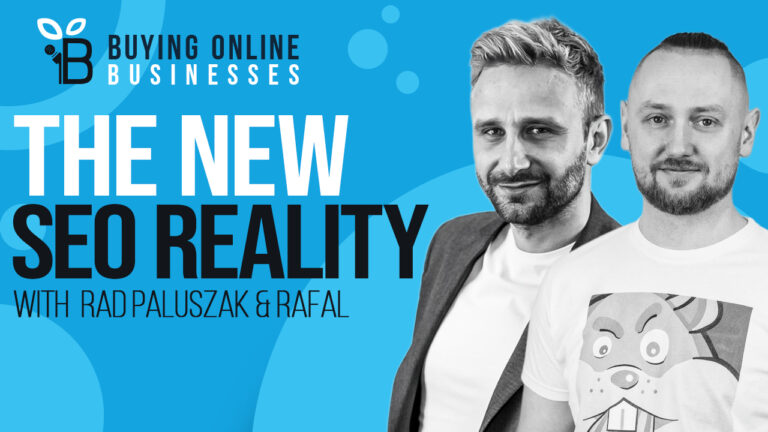
Ep 251: The New SEO Reality On How To Get Real Results For Your Content Website with Raf and Rad
Improve your site’s performance and learn how to create a link building campaign with Jaryd Krause and Maria Harutyunyan. Check out this episode!
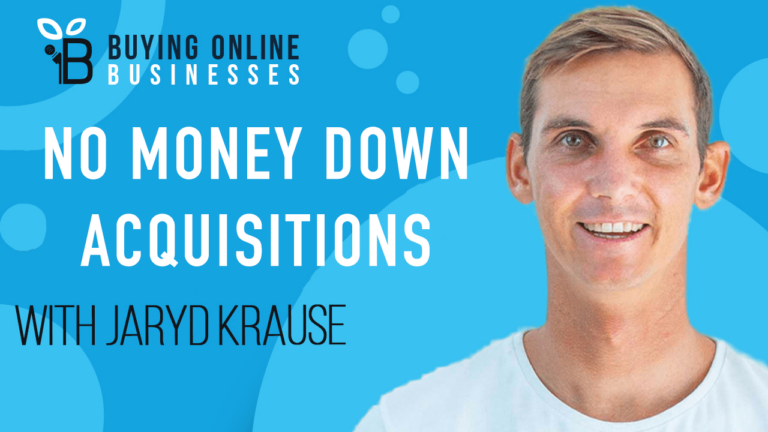
Ep 250: No Money Down Acquisitions – Can You Buy An Online Business With No Money?
Discover how to buy an online business with no money with Jaryd Krause. Know your options so you can make informed decisions.
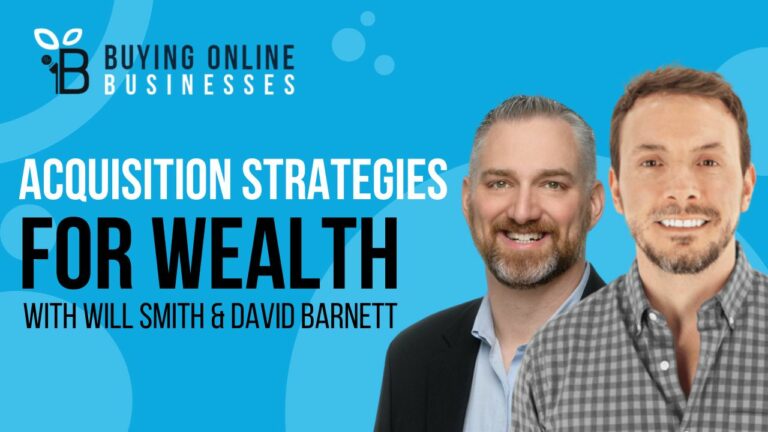
Ep 249: M&A Negotiation Strategies & Growth By Acquisition Blueprints with Will Smith & David Barnett
Gain insights about M&A negotiation strategies and growth by acquisition blueprints with Jaryd, Krause, Will Smith, and David Barnett.



